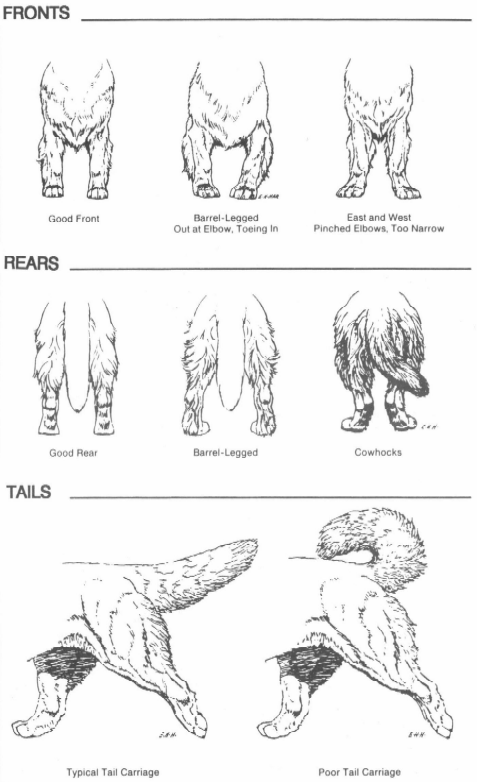
FOREQUARTERS
Shoulders are muscular and well laid back. Elbows lie directly below the highest point of the withers. Forelegs are muscular, heavily boned, straight, and parallel to each other, and the elbows point directly to the rear. The distance from elbow to ground equals about half the dog’s height. Pasterns are strong and slightly sloping. Feet are proportionate to the body in size, webbed, and cat foot in shape. Dewclaws may be removed.
Without correct structure of the foreassembly, perfection in all other body structure will suffer in proportion to the failure existing in the front. The shoulder blade should be broad, have hard sinewy muscle, and be firmly placed. The upper arm should be the same length as the shoulder blade and well muscled.. It should lie close to the ribs and should be capable of free movement. With the elbows lying directly below the highest point of the withers, correctly angulated forequarters will place the forelegs well under the body without too much distance between the fore and hind quarters. The better the match in correct angulation between the front and back assembly, the better the dog will move.
Turned-out, turned-in, splayed, or hare feet are incorrect. Dewclaws that are always found on the front legs need not be removed.
Bone should be in proportion to the size of the dog. A heavy coat can add false visual dimension to bone, so it should be felt for size and comparison. A standard location to assess bone is the forearm, just above the pastern. A Newfoundland should never be faulted for having too much bone.
HINDQUARTERS
The rear assembly is powerful, muscular, and heavily boned. Viewed from the rear, the legs are straight and parallel. Viewed from the side, the thighs are broad and fairly long. Stifles and hocks are well bent and the line from hock to ground is perpendicular. Hocks are well let down. Hind feet are similar to the front feet. Dewclaws should be removed.
Newfoundlands should not be cow-hocked, sickle-hocked, barrel-legged, nor pigeon-toed in the hindquarters. The muscling should be broad and hard.
Well bent stifles and hocks provide flexibility. One should be able to see the entire pads of the rear feet of a dog as he moves away.
From the perspective of the rear assembly, just as from that of the front assembly, rear and front angulation should be in balance. The well balanced Newfoundland will stand comfortably with his rear legs out from under him, with the hocks perpendicular to the ground.
| BACK | CONTENTS | NEXT |